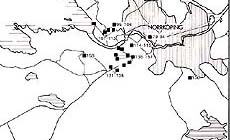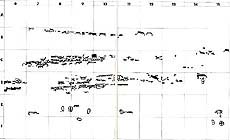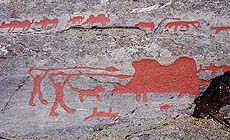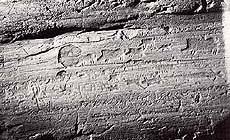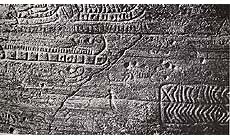|
|
 |
 |
Country: |
Sweden |
Locality: |
Himmelstadlund |
|
 |
Region: |
Östergötland |
Area: |
Östra Eneby |
|
 |
 |
|
|
|
|
| |
 |
Environment & Surface |
 |
 |
 |
|
Open-air
Shelter
Cave
Portable
Megalithic
|
Geography: |
Two completely visible hillocks, NE of the Motala stream, NW of E4 road, W of Norrköping. Recreation area, plain. Largest carvings situated NE of path, through the major area of the SE panels, and also in the NE smaller area. |
Proximity: |
Close proximity to Motala stream, and open arable land. The sea is visible in the far distant. Situated in an area with several rock carving localities, between the Lake Glan and so called Norrköping-fault. |
|
 |
Geology: |
Mica-schist and gneiss. |
Surface: |
Wide, rather smooth surface. Cracks and lines. |
|
|
|
|
 |
 |
|
|
|
|
| |
 |
Art |
 |
 |
 |
Description: |
Engravings
Paintings
Painted engravings
High or low-relief
Sculpture
Himmelstadlund, Östra Eneby parish. A total number of 1659 registered figures on 57 panels. The ship is the most dominating motif with a total number of 622 figures. One third of these are totally carved out, and others are contour-carved with crew strokes. Decoration in the hull exist especially in the W part of the locality. On some of the ships there are human figures and also tree-figures. There are 59 human figures, small and totally carved out, often depicted together with animals, spear, chariot, or on a ship. The total number of animal figures are 259, often small in size and totally carved out. Possibly depicying pigs. They are depicted in groups as the famous hoard on the NW major panel. There is also a possible human figure among these pigs, equipped with a spear or it is a shepherd with his stick. There is a distinct hunting scene with spear carrier, dogs and an oversized boar. Furthermore are horses represented and also goats. There is a total number of 33 weapon figures of which 13 are spears. There are 30 axe figures, the majority deeply carved out. There are 7 framed figures, a design specific for the province of Östergötland. The largest one is found in the NW part of the locality, and is decorated and is carried by 2 small human figures on a long pole, perhaps a spear. The symbolic designs are showing a rich variety of types, there are 47 wheel crosses, 17 circle figures and 92 foot prints, of which 19 placed in pairs. Unique is the 22 m row of paw prints, 25 in number, originally more. The stamps give an impression of a bear walking across the rock. The cup marks are relatively few in number, approximately 245 and spread out over the locality. In some cases there are younger figures carved above the older ones, for example totally carved out ship figures are superimposed by contour-carved ship figures, spears and animal figures.
|
Figures: |
total number 1659
622 ship figures
59 human figures
259 animal figures
33 weapon figures
47 wheel crosses
17 circle figures
92 foot prints
25 paw prints
245 cup marks
30 axes
|
|
 |
Chronology: |
Palaeolithic
Epipalaeolithic - Mesolithic
Neolithic
Copper Age
Bronze Age
Iron Age
Roman
Middle Age
Modern
Unknown
The rock carvings in Östergötland are generally dated to the Bronze Age, c. 1800-500 BC on basis of the position in the landscape, the relation to other ancient monuments and of the combinations of different figures and motifs.
|
Notes: |
The province of Östergötland in Sweden, has long been well-known for its profusion of rock carvings, but figurative carvings only abound in a small area to the W of Norrköping; elsewhere they are few and far between. It is probable that the Norrköping district was of importance as a religious centre on several spatial and social levels in a tribal society: local, regional and supra-regional; perhaps with Ekenberg functioning on the highest level. The widespread cup mark sites, on the other hand, were utilised for a domestic cult on a microlevel, probably prevailing into the Iron Age and perhaps longer (Selinge 1989:234). |
|
 |
 |
|
| |
 |
Bibliography |
 |
|
|
|
|
| |
 |
Conservation |
 |
 |
 |
Status: |
Public
Private
Park
Classified site
|
Risk: |
The rock carvings are fragile and the major risk are chemical weathering, which makes the hard quartzite losen up and fall out, leaving white dots on the darker rock surface. Also natural weathering (mechanical weathering) during winter/spring, when water freeze in cracks and openings in the rock, creates major damage to rock faces with carvings. The biological weathering is also a danger to the rock carvings, and even to intense cleaning of the rock surface during documentation can make the rock fragile and expose the carvings to wind, water and air-born pollution. The carvings are situated in a recreation area with a large number of people passing by. |
|
 |
Conservation: |
Good
Quite good
Mediocre
Bad
|
Intervention: |
Problems concerning conservation and preservation, registration and documentation of rock carvings in Scandinavia are discussed by several departments, i.e. Riksantikvaren in Norway, Riksantikvarieämbetet in Sweden, several universities and research departments. Different methods are tested, for example covering of carved surfaces, measuring of temperature and different contents in water and air and also the composition in the granite. Hollows and cracks in the rock surface can be repaired and carefully filled in. The carvings are partly painted. |
|
 |
 |
|
|
 |
By |
 |
|
| |
| Record n. 805 / 807 |
No commercial use is allowed. Specific © is mentioned in the captions or owned by each Author or Institution |
|
| |
 |
EuroPreArt, European Prehistoric Art, is a web-based archaeological project funded by the European Union which aims to establish a lasting data-base of European prehistoric art documentation, to launch the base of an European institutional network and to contribute to the awareness of the diversity and richness of European Prehistoric Art.
It is proposed by: Instituto Politécnico de Tomar (IPT, Portugal),
CUEBC - European University Centre for Cultural Heritage (Italy - Europe),
Consejo Superior de Investigaciones Científicas (España),
Asociación Cultural Colectivo Barbaón (España),
Université de Liège (Belgique),
Gotland University College (Sverige),
University College Dublin (Eire),
Cooperativa Archeologica Le Orme dell'Uomo (Italia),
Study Centre and Museum of Prehistoric Art of
Pinerolo (Italia),
The European Centre for Prehistoric Research in the Alto Ribatejo (Portugal),
ArqueoJovem - a youth NGO (Portugal).
|
|
|
|
 |
|
 NEW: Alpine rock paintings
NEW: Alpine rock paintings